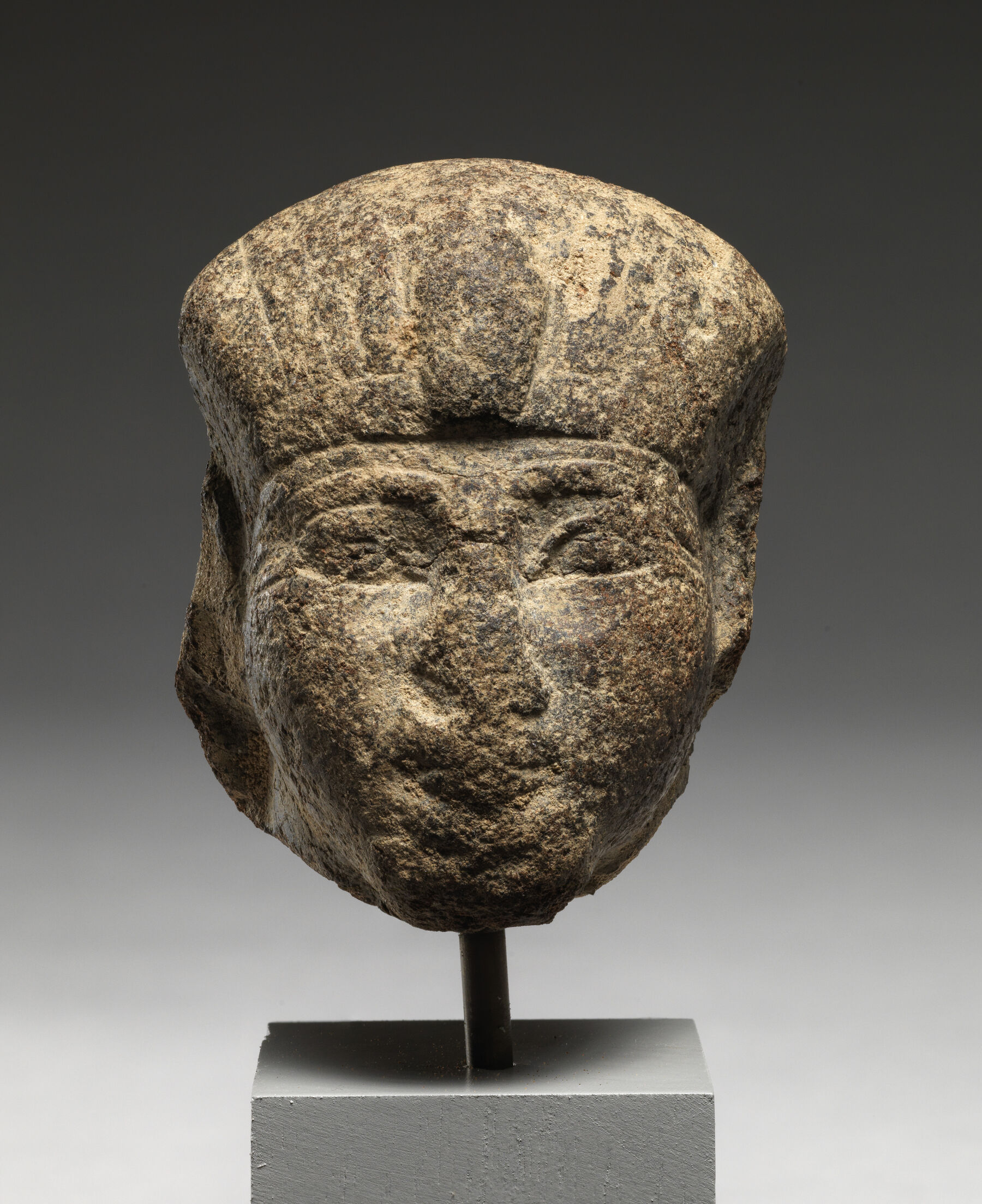Dynasty 12 royal statuary continues Upper Egyptian stylistic traditions established during the reign of Mentuhotep II, who reunified Egypt in the latter half of Dynasty 11. The shape of the eyes, eyebrows, lips, and cheeks remain consistent in statuary until the reign of the second king of Dynasty 12, Senusret I.1 This stylistic conformity between dynasties probably signifies the continuity of the king as the repository of divine kingship.2 Senusret I established a new naturalistic royal portrait that presents the sovereign as his own man.3
This small head belongs to a late Dynasty 11 king, either Mentuhotep II or III, or an early Dynasty 12 king.4 The ruler wears a broad striped nemes headdress with a uraeus on his brow. The king’s face is broad and oval. His straight brows are carved in high relief and curve downward at the outer ends. The eyes are wide and slightly slanted with pronounced inner canthi. The eyes are outlined with relief bands that end in “fishtail” cosmetic lines. The nose is damaged, but the broad curve of the nostrils can be made out. The remains of the mouth show thick lips that curl upwards into a smile.
MH
-
Fay, Biri. 2003. “L’art égyptien du Moyen Empire (Première partie).” Égypte 30: 31–54.. ↩︎
-
Assmann, Jan. 1996. “Preservation and Presentation of Self in Ancient Egyptian Portraiture.” In Studies in Honor of William Kelly Simpson, edited by Peter der Manuelian, 55–81. Boston: Dept. of Ancient Egyptian, Nubian and Near Eastern Art, Museum of Fine Arts.. ↩︎
-
Lorand, David. 2011. “La statuaire royale de Sésostris Ier: art et politique au début de la 12e dynastie.” Bulletin de la Société Française d’Égyptologie 180: 23–43.. ↩︎
-
Bourriau, Janine. 1988. Pharaohs and Mortals: Egyptian Art in the Middle Kingdom. Cambridge, UK: Cambridge University Press.; Lorand, David. 2016. “Did the ‘reunification style’ affect the Middle Kingdom royal statue production?” In Change and Innovation in Middle Kingdom Art, Proceedings of the MeKeTRE Study Day held at the Kunsthistorisches Museum, Vienna (3rd May 2013), edited by L. Hudakova, P. Janosi and A. Kahlbacher, 83–94. Middle Kingdom Studies 4. London: Golden House Publications.; Aldred, Cyril. 1970. 1970 “Some royal portraits of the Middle Kingdom in ancient Egypt.” Metropolitan Museum Journal 3: 27-50., Edinburgh, Royal Museum of Scotland, 1965.2; fig. 9, Basel, Museum der Kulteren, III.8397. ↩︎
Bibliography
- Aldred 1970
- Aldred, Cyril. 1970. 1970 “Some royal portraits of the Middle Kingdom in ancient Egypt.” Metropolitan Museum Journal 3: 27-50.
- Assmann 1996
- Assmann, Jan. 1996. “Preservation and Presentation of Self in Ancient Egyptian Portraiture.” In Studies in Honor of William Kelly Simpson, edited by Peter der Manuelian, 55–81. Boston: Dept. of Ancient Egyptian, Nubian and Near Eastern Art, Museum of Fine Arts.
- Bourriau 1988
- Bourriau, Janine. 1988. Pharaohs and Mortals: Egyptian Art in the Middle Kingdom. Cambridge, UK: Cambridge University Press.
- Fay 2003
- Fay, Biri. 2003. “L’art égyptien du Moyen Empire (Première partie).” Égypte 30: 31–54.
- Lorand 2011
- Lorand, David. 2011. “La statuaire royale de Sésostris Ier: art et politique au début de la 12e dynastie.” Bulletin de la Société Française d’Égyptologie 180: 23–43.
- Lorand 2016
- Lorand, David. 2016. “Did the ‘reunification style’ affect the Middle Kingdom royal statue production?” In Change and Innovation in Middle Kingdom Art, Proceedings of the MeKeTRE Study Day held at the Kunsthistorisches Museum, Vienna (3rd May 2013), edited by L. Hudakova, P. Janosi and A. Kahlbacher, 83–94. Middle Kingdom Studies 4. London: Golden House Publications.
